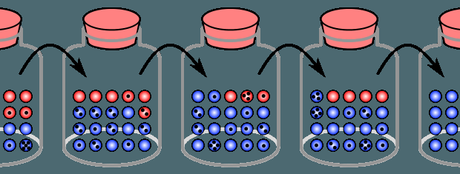
Evolution describes how animals change over time. Often this is driven by natural selection - a process which results in animals becoming better adapted for their environment. However, people often forget about natural selections little brother: genetic drift. Or to put it more simply "chance". Yes, evolution can change animals to become better adapted; but it can also change them for no real reason. New research suggests that the evolution of the Neanderthals may be the result of the latter.
Broadly speaking, genetic drift refers to how new mutations and features can spread through a population (causing it to change) even if they aren't beneficial. Maybe the competitors of a group are wiped out by a natural disaster, allowing the group (and its odd mutations) to flourish. Maybe one group migrates into a new region. Full of untapped resources, their population explodes. Maybe due to chance, one lineage just doesn't have as many offspring as another causing their mutations to vanish.
There's been a lot of debate over whether or not natural selection (where traits spread through a population because they confer an advantage) or genetic drift is the primary driving force of evolutionary change. The result of all this argument has been a resounding: it depends. In small groups genetic drift definitely seems to take a high priority. It doesn't take much chance (whatever that chance event might be) to tip the scales in favour of one change or another. Sometimes a single family dying could mean the extinction of a mutation; allowing others to rise to dominance simply because they dodged the meteor or whatever. On the other hand, these sorts of events would have a less significant impact on larger populations.
And that's where the Neanderthals enter into the picture. During their evolution they were living in ice age Europe. Now, granted it wasn't always frozen over but it was still a pretty tough place to live. As such, estimates indicate that the Neanderthal population size remained pretty low. Thus they would have been strongly influenced by genetic drift.
In fact, the dates key Neanderthal traits appear often correlate with particularly trying times where the Neanderthal populations would be extra small. At some points there appear to have been fewer than 8,000 Neanderthals on the planet.
The prominence of genetic drift in their evolution may go some way towards explaining the "quirks" of Neanderthal anatomy. For example, they had rather large noses. This had been explained as an adaptation to the cold environments (heating up the air before it entered the body). Yet when you look at living cold adapted species (including some groups of humans) the opposite trend is observed, with noses becoming smaller. Might the Neanderthal nose have developed by chance and not for any reason?
Now of course it's worth noting that this research doesn't actually establish that certain Neanderthal characteristics are the result of genetic drift. Simply that they were in a position to be strongly influenced by it. In other words (as with just about anything on this subject) more work is needed. After all, if the environment was harsh enough to limit their population it was likely exerting a strong pressure on them that could've drive more natural selection than expected.
Us modern humans, on the other hand, lived in a slightly large population. So we likely evolved for a reason.
Reference
Pearson, O. M. (2013). Hominin Evolution in the Middle-Late Pleistocene. Current Anthropology, 54(S8), S221-S233.
Rae, T. C., Koppe, T., & Stringer, C. B. (2011). The Neanderthal face is not cold adapted. Journal of human evolution, 60(2), 234-239.

